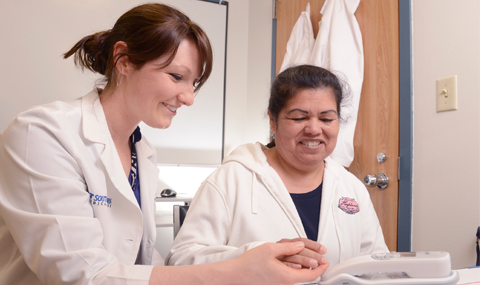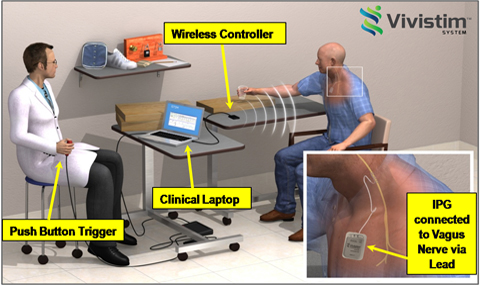Rogers Stroke Center site for test of implant aimed at restoring lost arm function after stroke
DALLAS – May 6, 2015 – UT Southwestern Medical Center will be one of three national sites to pioneer U.S. testing for an implant device that stimulates the vagus nerve in stroke patients to see whether it can help restore lost arm function.

The Vivistim® System device, developed by Dallas-based MicroTransponder Inc. with a license from UT Dallas, stimulates the neck’s vagus nerve, a key nerve stretching from the medulla oblongata in the brain down to the throat, larynx, trachea, lungs, heart, esophagus, and intestinal tract. Implanted under the collarbone, the device, which is about the size of a pacemaker, sends painless, half-second electrical pulses up the vagus nerve, causing chemicals called neuromodulators to be released in various parts of the brain. Alternate forms of vagus nerve stimulation therapy already are approved for use in the U.S. by the Federal Drug Administration for treating other illnesses, including depression and epilepsy.
“These neuromodulators appear to facilitate the creation of new neuron pathways in the brain, which play a key role in restoring muscle movement,” said Dr. Ty Shang, Assistant Professor of Neurology and Neurotherapeutics at UT Southwestern, who is heading the UT Southwestern arm of the trial. UT Southwestern is one of three sites in the nation.
“A stroke deprives brain cells of oxygen,” said Dr. Shang, a vascular neurologist who is part of UT Southwestern’s stroke team. “Without oxygen, the brain cells die, and can no longer perform the function for which they were intended. There has been no known way to regenerate new brain cells to replace them, but in early tests with this device, the brain appears to ‘rewire’ other cells to perform the function.
The study is sponsored by MicroTransponder Inc. and partially funded by the Texas Biomedical Device Center at UT Dallas. The Vivistim® system, designed to improve motor function in the more involved arm of a person following stroke, was studied starting in 2013 for efficacy and safety in a small study in Glasgow, Scotland. Individuals in the Glasgow study experienced meaningful functional improvements in their more involved arm. Many were able to resume daily activities like swimming, driving, and caring for grandchildren.

“VNS therapy may be the stimulus for motor relearning with the more involved arm for individuals following stroke. Gaining functional improvement in the impaired arm is an arduous task. VNS therapy might make achieving functional gains easier,” Dr. Shang said.
UT Southwestern researchers are seeking persons in the Dallas-Fort Worth metroplex who had a stroke four months to five years ago to participate in the trial. After having outpatient surgery to implant the device, participants will be scheduled for 18, 90-minute sessions of intensive, task-specific therapy over a six-week period with quarterly follow-up evaluations for the next year. Interested participants can register by contacting the Department of Physical Therapy at 214-648-1533. The therapy interventions are in the Upper Extremity Motor Laboratory under the leadership of Dr. Patricia Smith, Chairman of Physical Therapy.
Stroke occurs when blood supply to the brain is suddenly interrupted, typically when blood vessels supply the brain become blocked or burst. About one in six Americans will experience a stroke after age 65, though it can occur at any age, according to research supported by the National Institutes of Health (NIH). While fatal in 10 to 20 percent of cases, stroke can result in lost mobility such as arm or leg function, impaired speech, and cognitive problems, making it a major cause of disability in the U.S. Stroke is the number one cause of serious adult disability in the United States, according to the National Institute of Neurological Disorders and Stroke, part of the NIH.
UT Southwestern stroke specialists pioneered the development of some of the most advanced and effective brain aneurysm procedures in use today. In 1989, UT Southwestern researchers refined a fast-acting drug called tissue plasminogen activator, or tPA, which can rapidly dissolve blood clots in patients with ischemic stroke, greatly reducing the risk of death or severe disability.
UT Southwestern’s Neurology Clinic is one of the nation’s top stroke treatment facilities, treating more aneurysm cases than any other facility.
The Joint Commission and the American Heart Association(AHA)/American Stroke Association(ASA) jointly certified UT Southwestern University Hospitals as an Advanced Comprehensive Stroke Center in 2014, a distinction for hospitals fostering specialized stroke care and expertise for patients. UT Southwestern’s Robert D. Rogers Advanced Comprehensive Stroke Center is the first and only AHA/ASA/Joint Commission-certified Advanced Comprehensive Stroke Center in North Texas and only the second in Texas.
UT Southwestern’s multidisciplinary cerebrovascular program brings together neurologists, neuroradiologists and neurosurgeons with vascular, endovascular and critical-care expertise to treat all forms of stroke and blood-vessel disease affecting the brain and spinal cord. This includes referrals, both acute and subacute, for complex cases throughout Texas and the surrounding five-state area. The certification requires that the hospital provide ready access to the technology and medications that can limit damage during or after a stroke. A 2010 study in the journal Stroke found that stroke centers following national guidelines recorded fewer fatalities and reduced institutional care a year later compared with general hospitals; had lower mortality rates during a nine-year follow-up; and increased median survival rates.
About UT Southwestern Medical Center
UT Southwestern, one of the premier academic medical centers in the nation, integrates pioneering biomedical research with exceptional clinical care and education. The institution’s faculty includes many distinguished members, including six who have been awarded Nobel Prizes since 1985. The faculty of more than 2,700 is responsible for groundbreaking medical advances and is committed to translating science-driven research quickly to new clinical treatments. UT Southwestern physicians provide medical care in 40 specialties to about 92,000 hospitalized patients and oversee approximately 2.1 million outpatient visits a year.
###
Media Contact: Gregg Shields
214-648-3404
gregg.shields@utsouthwestern.edu
